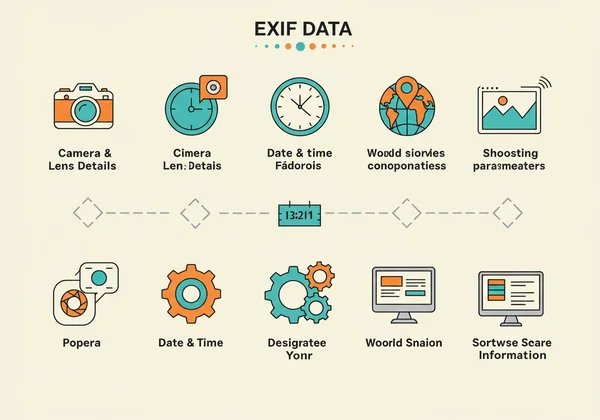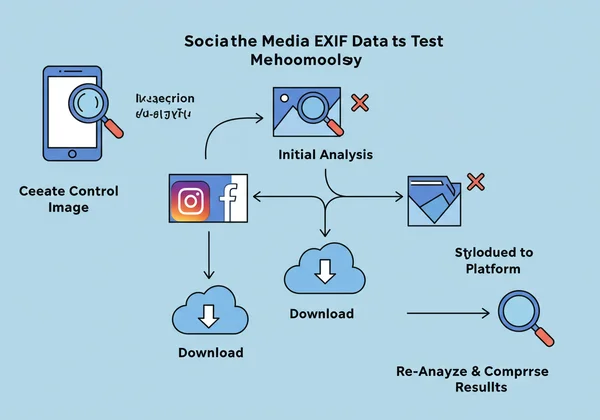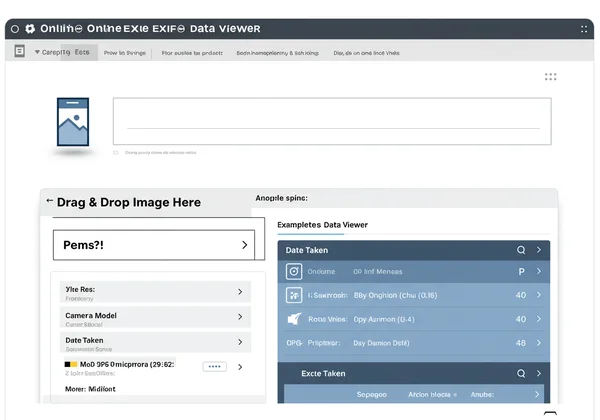Do Social Media Sites Strip EXIF Data? 2025 Test
Every photo you share online tells a story, but sometimes it shares more than you intend. Hidden within your image files is a treasure trove of information known as EXIF data. This digital metadata can include everything from the camera you used to the precise GPS location where the photo was taken. This raises a critical question for anyone active online: does Facebook/Instagram/Discord remove exif data?
Digital privacy is a growing concern, and trusting social media platforms with your personal photos often feels like a gamble. You deserve to know exactly what happens to your photo's hidden data when you click "upload." That's why we conducted a definitive 2025 test to find out the truth. Before you share your next memory, check your photos now to see what you might be revealing.

Understanding EXIF Data & Your Photo Privacy
To grasp the importance of this test, it's essential to first understand what this embedded data is and the privacy implications it carries. Many users are unaware that this information is automatically attached to every picture they take with a modern camera or smartphone.
What is EXIF Data in Your Photos?
EXIF, which stands for Exchangeable Image File Format, is the standardized way of storing image metadata directly within the image file itself. Think of it as a digital label that contains a wealth of information about the photo, including:
- Camera & Lens Details: Make, model, serial number.
- Shooting Parameters: Aperture, shutter speed, ISO, focal length.
- Date & Time: When the photo was taken, down to the second.
- GPS Coordinates: The exact latitude and longitude of where the image was captured.
- Software Information: The program used to view or edit the photo.
This data is incredibly useful for photographers looking to analyze their settings but can become a significant privacy concern for the average social media user.

The Privacy Risks of Sharing Metadata Unknowingly
The most significant risk comes from GPS data. Sharing a photo taken at home could inadvertently broadcast your home address to the world. A picture from your child's park could reveal their regular hangouts. These photo details, when shared unknowingly, create a map of your life for anyone to see.
Beyond location, other data points can be used to build a profile about you, including the devices you own and your daily routines. The first step to protecting yourself is knowing what information your photos contain. A quick and secure photo metadata viewer is the best way to get a clear picture.
Our 2025 Social Media EXIF Data Test Methodology
To provide clear and trustworthy answers, we established a rigorous testing process. We wanted to simulate the exact experience of a typical user to see how major social media platforms handle social media photo privacy.
How We Conducted the Experiment (Step-by-Step)
Our methodology was straightforward and repeatable, ensuring our results are both accurate and relevant for 2025.
-
Create the Control Image: We took a new photo with a modern smartphone, ensuring all settings, including location services, were enabled. This created a test image rich with its original metadata, including camera model, exposure settings, and precise GPS coordinates.
-
Initial Analysis: We first analyzed the original image to create a baseline record of all its metadata.
-
Upload to Platforms: We uploaded the exact same photo to Instagram, Facebook, and Twitter (X) using their standard mobile apps.
-
Download and Re-Analyze: After uploading, we downloaded the photo back from each platform. This is the version that other users would see and save.
-
Compare Results: We performed a final metadata analysis on each downloaded image, comparing it against our original file to see exactly what was stripped, what was modified, and what, if anything, remained.

Tools Used for Accurate Metadata Analysis
For our analysis to be credible, we needed a powerful and reliable exif reader. Crucially, we needed a tool that respected our privacy. For this, we used a premier online exif viewer that processes all analysis directly in your browser. This key feature ensures your images are never uploaded to a third-party server, guaranteeing data integrity and privacy.
Instagram's EXIF Data Handling & Our Test Results
As one of the world's largest photo-sharing platforms, how Instagram handles instagram exif data is of huge concern to millions of users. Our test revealed a clear and consistent policy.
What Instagram Strips: A Detailed Look
Our findings show that Instagram is extremely aggressive with its exif data removal. Upon uploading our test image, the platform stripped nearly all of the original metadata. Key data points that were removed include:
- GPS Location: Completely gone. There was no trace of the original coordinates.
- Camera/Lens Information: The make, model, and settings were removed.
- Original Date/Time: The specific timestamp of when the photo was taken was stripped.
What Instagram Retains (If Anything)
While almost everything is removed, Instagram does embed some of its own metadata. This typically includes processing information and identifiers related to its own servers. From a user privacy perspective, the good news is that sensitive, personally identifiable information is effectively scrubbed from photos you share on the platform.
Facebook's EXIF Data Removal & Analysis
Given that Facebook owns Instagram, it's no surprise that its approach to handling image metadata is very similar. Users concerned about facebook remove metadata can rest relatively easy.
Our Findings on Facebook's Metadata Policy
Our test confirmed that Facebook also employs a policy to strip exif data from uploaded photos. Just like Instagram, the downloaded image from Facebook was clean of all sensitive information. The GPS coordinates, camera details, and original timestamps were nowhere to be found.
Facebook replaces the original metadata with its own, smaller set of metadata. This primarily relates to copyright information and image processing details specific to Facebook's infrastructure.
The Impact on Photo Privacy for Facebook Users
For the average user, this is a positive outcome for image privacy. It means that even if you forget to scrub your photos before uploading, Facebook acts as a safety net, removing potentially revealing information like your location. However, relying on a third party for your privacy is never the best strategy. The safest approach is always to check your photo details yourself before they ever leave your device.
Twitter (X) & Your Photo GPS Data
Twitter, now known as X, has long been a platform for real-time updates, often accompanied by photos. Our test looked specifically at twitter photo gps data and the platform's overall metadata policy.
How Twitter (X) Processes Image Metadata
The results for Twitter (X) were consistent with the other platforms. Our test showed that upon uploading a photo, Twitter (X) strips all sensitive metadata. The downloaded image was free of any GPS coordinates, camera information, or other identifying metadata from the original file. This policy helps protect users who might accidentally share their location in the heat of a live-tweeting moment.
Protecting Your EXIF Data Before Sharing
While our 2025 test shows that major social media platforms are currently doing a good job of stripping EXIF data, policies can change without notice. The most reliable way to protect your privacy is to take control of it yourself. You should always check exif data before you share any image online.
Simple Steps to Strip Metadata from Photos
There are several ways to practice good digital hygiene. Some operating systems, like Windows and macOS, have built-in tools to view and remove exif data. You can typically right-click an image file, go to "Properties" or "Get Info," and manually remove the data. However, this process can be slow and cumbersome, especially if you have many photos.
Using a Secure Online Tool for Quick Checks
The easiest and most secure way to manage your photo metadata is by using a dedicated tool. This free online EXIF data viewer provides an instant and completely private solution. Because it works entirely within your browser, your photos are never uploaded to a server, giving you total peace of mind.
Before you post your next photo, simply drag and drop it onto the homepage. In seconds, you'll see a complete breakdown of all hidden data. This empowers you to make an informed decision about your privacy before you share. It's the ultimate secure photo check.

Empowering Your Photo Privacy Decisions
Our 2025 tests demonstrate that major platforms like Instagram, Facebook, and Twitter (X) are indeed removing sensitive EXIF data from uploaded photos. While this offers a degree of protection, it's vital not to become complacent. The only person you can truly trust with your data is yourself.
By making it a habit to check your photos before sharing, you take back control of your digital footprint. Knowledge is power, and understanding the data hidden in your images is the first step toward smarter, safer sharing. Try our free tool today and see for yourself what your photos are saying about you.
Frequently Asked Questions About Social Media & EXIF Data
Does Facebook, Instagram, or Discord remove EXIF data from photos?
Yes. Based on our 2025 tests, both Facebook and Instagram actively strip most of this metadata from photos upon upload, including sensitive information like GPS location and camera settings. While Discord was not part of this specific test, it is also widely reported to remove metadata to protect user privacy.
Does EXIF data show location or GPS coordinates?
Yes, if your camera or smartphone's location services were enabled when the photo was taken, the file's metadata can contain the precise latitude and longitude. This is one of the biggest privacy risks, which is why it's crucial to check your images before sharing.
How do I remove EXIF data from my photos before sharing them online?
You can use built-in operating system tools (like File Properties on Windows) or dedicated software. However, the simplest method is to first use an online exif viewer to see what data exists and then use an app or software designed to strip the metadata before you upload it anywhere.
How can I check what metadata is in my photo?
The most secure and straightforward way is to use a browser-based tool like our secure photo checker. You can simply drag and drop your image file onto the homepage, and it will instantly display all embedded EXIF, IPTC, and XMP data without ever uploading your file to a server.
Do screenshots contain EXIF data?
Typically, no. Screenshots capture the pixels on your screen at a moment in time and do not usually include the rich metadata that a camera does. They may contain some basic metadata, like creation date and color profile, but they are generally free of sensitive information like GPS coordinates or camera details.